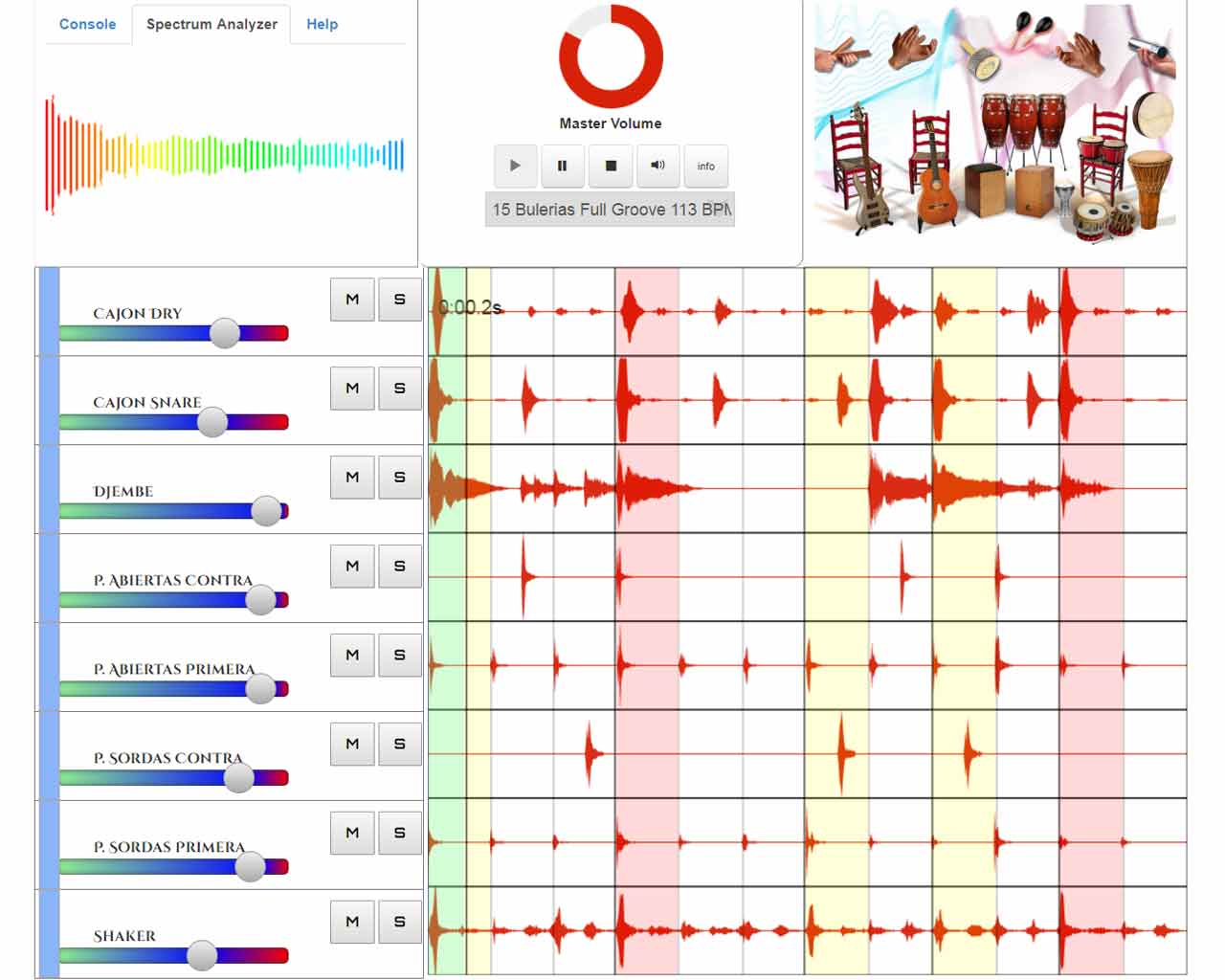
FOR SUBTITLED TRANSLATION TO ANY LANGUAGE:
(click 1.) press: “CC” button, down on the right side (underlined with a red line – means subtitles ON)
(click 2.) press: “a small gear” button, to the right, next to it, and then:
(click 3.) press: “Subtitles CC”, and then:
(click 4.) press: “Auto-translate” – first, and finally:
(click 5.) in the popup menu – select the desired language…:
This software is too complex to be viewed on less than 720p resolution.
Flamenco Bulerias & Alegrias Multi-Track loop Player™ samples have been recorded at the highest quality – 24 bits and 48 000 Hz. Depending on the soundboard that you are using for playback – the sound may be slightly distorted on the hitpoints. It happens especially if a lot of tracks are playing back simultaneously. On some old Android systems, there could be a delay in looped playback. Of course that the Gypsy rule: “how much money – that much music” is of big importance here. The sound quality depends definitely on your D/A device, and the quality of the conversion from digital to analog sound your soundboard can achieve.
 If you are using the integrated soundcard, (laptop, tablet, or desktop with soundboard integrated on the motherboard) – to improve the sound quality, you can turn down to 85% your main speaker output on the computer. Therefore, turn up the volume on your external speakers slightly.
If you are using the integrated soundcard, (laptop, tablet, or desktop with soundboard integrated on the motherboard) – to improve the sound quality, you can turn down to 85% your main speaker output on the computer. Therefore, turn up the volume on your external speakers slightly.
Professional producers follow the first and most important principle when mixing songs. They start by soloing just one channel with its level to approximately 90% (to leave enough headroom for postproduction). Then they add channels one by one to the mix, by slowly raising the volume of each channel until it can be heard perfectly with the lowest volume possible.
For tuning the percussion instruments some basic tools are always needed. Or some type of a screwdriver, or some type of a wrench. So, on live performances, we can often see various sets of the same instrument – tuned to different pitches. They are often placed all around the percussionist on the stage, (so he doesn’t have to re-tune them rapidly between songs…)
The only “non-chromatic” or “non-tunable” percussion used in flamenco today are: “Palmas” (handclaps), Shaker, Maracas, Cabasa, Caxixi, etc… So, all the similar “shaker type” small Latin percussion. Egg or Ice Shaker, Shekere (like a rustic Cabasa, but from a real pumpkin, with the perforated fruit seeds instead of the metal beads), etc…
Flamenco Bulerias & Alegrias Multi-Track Loop Player™ uses its world unique Flamenco Loop Sets Samples Database. The flamenco bulerias and alegrias loop set databases are specially designed and produced to give you the clearest insight into the very essence of the flamenco rhythm – compás.
The beats are shown over the waveforms of the channels on 12/8 measure grid. The heavy beats are marked with yellow transparent squares. The accented heavy beats – with red and non-accented beats are colorless, or white.
Cajón has a “non-tunable” high sounds, but the bass note can often have an exact main frequency. It can impact the song harmonically, having like a bass “pedal-tone” note repeating throughout the entire arrangement. That note depends on the tonality of the song being played. Neither of the cajons used – was tuned to any specific frequency, to avoid any harmonic dependence. But lately, cajóns are often tuned to an exact frequency, by tightening the front board screws. They are pushing the front board harder onto the front edge, that has 2 different “levels”. (like “a step”, with the lower inner edge). The outer rim is protruding some 5 mm more than the inner part where the screws go. So, tightening the screws – curves up inwards the whole front board (making a parabola in the cross-section). As we go tightening, it allows us to over-tense the front board raising the main frequency. On some cajóns, we can raise it to a 5th. So, on some modern-day Cajóns, we can precisely define the bass tone frequency if we want to…
Palmas (handclaps) are the essential “instrument” in flamenco. They are divided into “sordas” and “abiertas” which translates as “deaf” and “open”. The “sordas” are produced with the whole palm surface of both hands, and the sound is deeper. While the “abiertas” is played with just 3 fingers of one hand, and the palm of the other hand. It is a “dry” and generally louder sound. The name also depends on the rhythmical alignment of the hits. If Palmas are hitting the first beats, the name is “Primera”, and if they are playing on break-beats, the name is “Contra”. The musicians that play the “palmas” are called “Los Palmeros”. They HAVE TO PLAY SO PRECISELY and BE SO WELL EXPERIENCED, that there is like a rule in the world of flamenco. Only after approximately one half of the century – you can play “las Palmas” properly..! So, “Los Palmeros” all have to be – AT LEAST OVER 60 YEARS OLD TO BE ANY GOOD in playing.
The Palmas tracks are divided into 4 channels. It is the same way “Los Palmeros” naturally take roles when performing for recording: Palmas Sordas Primera, Palmas Sordas Contra, Palmas Abiertas Primera, and Palmas Abiertas Contra. Note that THESE PALMAS TRACKS ARE THE BEST POSSIBLE LEARNING EXAMPLES FOR FLAMENCO PALOS.
Tablas – both “Dayan” (the big drum) and “Bayan” (the small drum) were tuned to the note C#. Tablas are commonly tuned to either the note C, C#, or the note D, to match the bass string on Tanpura or Sitar in Indian music.
Djembe samples are from the originally made instrument from “Pita”, a type of Agave plant, that I carved myself, in the original African way. This is not a factory produced Djembe from a palm tree trunk, made on a lathe. It is a hand made instrument, made from a hollowed Cactus tree trunk, that has the wood grain following the trunk curve from top to bottom. It is an enormous job to make one, and I was crazy to start it but I had to finish it, despite days and days of work. I had all the power tools at my disposal. I destroyed my hands, so I don’t recommend it. The hollow trunk, in the end, after a week of carving and burning, soaked approximately one liter of linseed oil. It is tuned with the rope and a system of nodes. They are going around in a spiral, tensing the vertical ropes that hold the upper metal ring. The leather from the goat is bent around the bottom ring and pinched with the top one. It’s shaved and filed with sandpaper afterward. It doesn’t have a precisely audible main frequency because it is just too low, (moves the room walls, and creates earthquake-like sound) around 35 Hz. But for the recording, it was tuned so that its most audible harmonic is the note natural B = 123,47 Hz.
Shaker in flamenco is quieter than in Latin jazz. The shaker should NEVER overpower the guitar strumming in flamenco. It would take over the lead groove of the rhythm carried by guitars. So just have it @ lower volume, so that your strumming makes the groove and not the shaker. The sampled shakers are the Egg or Ice Shaker and the standard Latin Shaker in many forms. From the professional shakers from famous manufacturers to the homemade ones, with metal buckshot pellets and tin cans. Also sometimes even toy plastic shakers, that had some auditive peculiarity and were interesting because of it. I used literally everything that makes shaker type sound as a shaker instrument. Sometimes even squashing plastic bags to imitate it if the accents and shuffle I’m playing are matching the accents of a certain compás of flamenco bulerias or alegrias.

